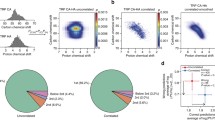Abstract
The identification of proton contacts from NOE spectra remains the major bottleneck in NMR protein structure calculations. We describe an automated assignment-free system for deriving proton contact probabilities from NOESY peak lists that can be viewed as a quantitative extension of manual assignment techniques. Rather than assigning contacts to NOESY crosspeaks, a rigorous Bayesian methodology is used to transform initial proton contact probabilities derived from a set of 2992 protein structures into posterior probabilities using the observed crosspeaks as evidence. Given a target protein, the Bayesian approach is used to derive probabilities for all possible proton contacts. We evaluated the accuracy of this approach at predicting proton contacts on 60 15N separated NOESY and 13C separated NOESY datasets simulated from experimentally determined NMR structures and compared it to CYANA, an established method for proton constraint assignment. On average, at the highest confidence level, our method accurately identifies 3.16/3.17 long range contacts per residue and 12.11/12.18 interresidue proton contacts per residue. These accuracies represent a significant increase over the performance of CYANA on the same data set. On a difficult real dataset that is publicly available, the coverage is lower but our method retains its advantage in accuracy over CANDID/CYANA. The algorithm is publicly available via the Protinfo NMR webserver http://protinfo.compbio.washington.edu/protinfo_nmr.
Similar content being viewed by others
References
Bailey-Kellogg C., Widge A., Kelley J.J., Berardi M.J., Bushweller J.H., Donald B.R. (2000). J. Comput. Biol. 7: 537–558
Berman H., Henrick K., Nakamura H. (2003). Nat. Struct. Biol. 10: 980
Grishaev A., Llinas M. (2002). J. Biomol. NMR 24: 203–213
Grishaev A., Llinas M. (2004). J. Biomol. NMR 28: 1–10
Guntert P. (2004). Methods Mol. Biol. 278: 353–378
Herrmann T., Guntert P., Wuthrich K. (2002). J. Mol. Biol. 319: 209–227
Huang Y.J., Moseley H.N., Baran M.C., Arrowsmith C., Powers R., Tejero R., Szyperski T., Montelione G.T. (2005). Methods Enzymol. 394: 111–141
Hung L.H., Ngan S.C., Liu T., Samudrala R. (2005). Nucl. Acids Res. 33: W77–80
Hung L.H.. and Samudrala R. (2006) submitted
Hung L.H., Samudrala R. (2003a). Protein Sci. 12: 288–295
Hung L.H., Samudrala R. (2003b). Nucl. Acids Res. 31: 3296–3299
Li W., Zhang Y., Kihara D., Huang Y.J., Zheng D., Montelione G.T., Kolinski A., Skolnick J. (2003). Proteins 53: 290–306
Linge J.P., O’Donoghue S.I., Nilges M. (2001). Methods Enzymol. 339: 71–90
Mumenthaler C., Guntert P., Braun W., Wuthrich K. (1997). J. Biomol. NMR 10: 351–362
Nilges M., Macias M.J., O’Donoghue S.I., Oschkinat H. (1997). J. Mol. Biol. 269: 408–422
Rieping W., Habeck M., Nilges M. (2005). Science 309: 303–306
Rohl C.A., Baker D. (2002). J. Am. Chem. Soc. 124: 2723–2729
Seavey B.R., Farr E.A., Westler W.M., Markley J.L. (1991). J. Biomol. NMR 1: 217–36
Vinarov D.A., Lytle B.L., Peterson F.C., Tyler E.M., Volkman B.F., Markley J.L. (2004). Nat. Methods 1: 149–153
Wand A.J., Nelson S.J. (1991). Biophys. J. 59: 1101–1112
Wang G., Dunbrack R.L. Jr. (2003). Bioinformatics 19: 1589–1591
Word J.M., Lovell S.C., Richardson J.S., Richardson D.C. (1999). J. Mol. Biol. 285: 1735–1747
Wuthrich K. (1986) NMR of Proteins and Nucleic Acids, John Wiley and Sons, Inc
Acknowledgements
This work was supported in part by a Searle Scholar Award, a NSF CAREER award (IIS-0448502), NSF grant DBI-0217241, and NIH grant GM068152-01.
Author information
Authors and Affiliations
Corresponding author
Rights and permissions
About this article
Cite this article
Hung, LH., Samudrala, R. An automated assignment-free Bayesian approach for accurately identifying proton contacts from NOESY data. J Biomol NMR 36, 189–198 (2006). https://doi.org/10.1007/s10858-006-9082-1
Received:
Revised:
Accepted:
Published:
Issue Date:
DOI: https://doi.org/10.1007/s10858-006-9082-1




